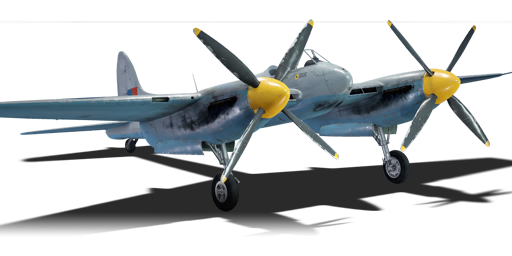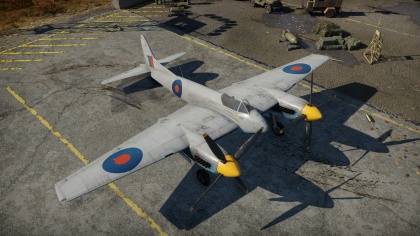Hornet Mk.III
Contents
Description
The Hornet Mk.III is a rank IV British twin-engine fighter
with a battle rating of 5.3 (AB), 6.0 (RB), and 5.7 (SB). It was introduced in Update 1.71 "New E.R.A.".
General info
Flight performance
For pilots who loved the Mosquito, the Hornet is a dream come true.
As a descendant of the Mosquito FB Mk VI, it maintains many similarities to its older brother, namely an all-wooden construction and the iconic de Havilland tail design. However, the Hornet somehow managed to improve on the already excellent Mosquito platform, increasing speed, manoeuvrability and armament while reducing overall aircraft proportions. From takeoff and into its flight, the Hornet is an overall smooth operator with brutal speed and excellent manoeuvrability, especially for a twin-engined fighter. However, it's still a twin-engined fighter which means it can still be outmanoeuvred by most single-engined opponents which it faces, namely Bf 109s and most Italian fighter aircraft.
| Characteristics | Max Speed (km/h at 5,791 m) |
Max altitude (metres) |
Turn time (seconds) |
Rate of climb (metres/second) |
Take-off run (metres) | |||
|---|---|---|---|---|---|---|---|---|
| AB | RB | AB | RB | AB | RB | |||
| Stock | 716 | 698 | 11500 | 26.8 | 27.5 | 19.2 | 19.2 | 500 |
| Upgraded | 805 | 756 | 23.9 | 25.0 | 34.2 | 25.2 | ||
Details
| Features | ||||
|---|---|---|---|---|
| Combat flaps | Take-off flaps | Landing flaps | Air brakes | Arrestor gear |
| ✓ | ✓ | ✓ | X | X |
| Limits | ||||||
|---|---|---|---|---|---|---|
| Wings (km/h) | Gear (km/h) | Flaps (km/h) | Max Static G | |||
| Combat | Take-off | Landing | + | - | ||
| 0 | 324 | 380 | 380 | 287 | ~8 | ~4 |
| Optimal velocities (km/h) | |||
|---|---|---|---|
| Ailerons | Rudder | Elevators | Radiator |
| < 420 | < 390 | < 450 | > 324 |
Survivability and armour
- 38 mm Bulletproof glass in front of the pilot
- 12.7 mm Steel plate behind the pilot
- Two 3 mm Steel boxes behind the pilot in the fuselage
- Critical components located at the front of aircraft (fuel, pilot, engine, controls)
- Lots of fuel tanks in the wings
Armaments
Offensive armament
The Hornet Mk.III is armed with:
- 4 x 20 mm Hispano Mk.V cannons, chin-mounted (190 rpg = 760 total)
Suspended armament
The Hornet Mk.III can be outfitted with the following ordnance:
- Without load
- 2 x 500 lb G.P. Mk.IV bombs (1,000 lb total)
- 2 x M.C. 1,000 lb Mk.I bombs (2,000 lb total)
- 8 x AP Mk I rockets
- 8 x AP Mk II rockets
- 8 x RP-3 rockets
- 2 x 500 lb G.P. Mk.IV bombs + 4 x AP Mk I rockets (1,000 lb total)
- 2 x 500 lb G.P. Mk.IV bombs + 4 x AP Mk II rockets (1,000 lb total)
- 2 x 500 lb G.P. Mk.IV bombs + 4 x RP-3 rockets (1,000 lb total)
- 2 x M.C. 1,000 lb Mk.I bombs + 4 x AP Mk I rockets (2,000 lb total)
- 2 x M.C. 1,000 lb Mk.I bombs + 4 x AP Mk II rockets (2,000 lb total)
- 2 x M.C. 1,000 lb Mk.I bombs + 4 x RP-3 rockets (2,000 lb total)
Usage in battles
Being a descendant of the legendary Mosquito, one should expect a similar playstyle with the Hornet. However, due to the vastly improved performance, the aircraft can perform amicably in most situations it is thrown in.
Fighter: The Hornet does very well in a dogfighting situation for a heavy fighter. It can use its powerful quad Hispano Mk.V's to shred any fighter which falls within its gun sights. However, one should take note that most single-engined fighters will turn circles around the Hornet, so turn-fighting should be avoided where possible. Naturally, there are some exceptions to this rule such as the P-47N-15, which you cannot match the Hornet's turn time.
High speed and great climb rate coupled with its amazing armament make the Hornet an extremely potent user of the Boom & Zoom fighting doctrine. Always attempt to maintain an energy and altitude advantage versus the enemy aircraft and avoid tunnel vision which means, be aware of the aircraft around you. Tunnel vision prevents you from seeing an enemy aircraft get the drop on you until its too late and either tracer fire is whizzing past or the Hornet's engine is on fire.
Ground Attacker: When aced, the Hornet can load 4 AP or RP-3 rockets and two 1,000 lb bombs. This, combined with the performance of the Hornet and power of the Hispano's allow it to be an amazing ground attacker that can shred any ground target in sight. The AP rockets are your best bet when it comes to ground attack, as they are more accurate than the RP-3's, fly faster and due to the higher speed, impact harder and penetrate more armour. However, when destroying light targets, the RP-3's are better due to the increased explosive yield.
Bomber Hunter: Due to its amazing performance, powerful armament and air defence fighter spawn point, the Hornet can make for a powerful interceptor when played carefully. Climb to bomber altitudes (4,000 metres and up) and begin prowling for a target. When attacking bombers, the worst angle of attack is from the rear, typically most bombers have their heaviest armament here, not to mention bullet impact is harder (especially from .50 calibre machine guns and 20 mm cannons) as the aircraft is flying towards a speeding bullet, increasing the damage it will do and the likelihood of being hit. Notable examples you can encounter at this rank are the B-29A-BN, B-17G-60-VE, PB4Y-2, He 177 A-5, G8N1 and the premium Be-6. Remember, the body of the aircraft can soak up a lot of damage, instead dive from above or climb from below and aim for the wings, without engines or a wing, the bomber will fall like a rock. Attacking from oblique angles makes it difficult for the bomber gunners to acquire a target solution and causes them to traverse and fire which spreads out their bullet patterns making it more difficult to hit a speeding target.
Manual Engine Control
| MEC elements | ||||||
|---|---|---|---|---|---|---|
| Mixer | Pitch | Radiator | Supercharger | Turbocharger | ||
| Oil | Water | Type | ||||
| Controllable | Controllable Auto control available |
Not controllable Not auto controlled |
Controllable Auto control available |
Combined | Controllable 2 gears |
Not controllable |
Modules
| Tier | Flight performance | Survivability | Weaponry | |||
|---|---|---|---|---|---|---|
| I | Fuselage repair | Radiator | Offensive 20 mm | HMBC mk.2 | ||
| II | Compressor | Airframe | New 20 mm cannons | GRC mk.8 | ||
| III | Wings repair | Engine | HLBC mk.2 | HRC mk.9 | ||
| IV | Engine injection | Cover | HRC mk.8 | |||
Your intended role of the Hornet decides which upgrades you go for first. When going for a ground attacker, focus the payload modules and cannon upgrades, with survivability modules coming next due to needing to lower the extra weight the payloads add.
When going for any other role, the belts and cannons should come first, followed by the performance upgrades, ultimately leading to Engine Injection, the Holy Grail of performance upgrades.
Pros and cons
Pros:
- Excellent armament, the Hispano Mk. V has a high rate of fire and causes a lot of fragmentation damage
- Extremely quick, can compete with some of the best single-engined fighters
- Has excellent payload options, several varieties of rockets and up to 2,000 lb in bombs
- Good amount of ammo for the cannons
- Quite manoeuvrable for a twin-engined fighter, as to be expected of the descendant of the Mosquito
- Fantastic climb rate, especially when spaded
- Thin body for a twin-engined fighter
- Experience with the Mosquito transitions between the planes
- Lenient stock grind
Cons:
- Not great at killing heavy bombers like the He 177, susceptible to engine damage or a knocked out pilot
- Matchmaking will pit you against some serious foes
- Despite the durable construction, the Hornet is made out of wood, meaning you cannot take much damage and remain in the fight
- Fires deal serious damage to a wooden plane
- Wings are littered with fuel tanks
- Despite the thin body, it is still a large target
- Carrying the max payload has a significant effect on flight performance
History
The de Havilland Hornet first started out as a private venture by the de Havilland company. Having built the extremely successful Mosquito multi-role fighter, the company wants to improve on the design to make a faster and longer ranged heavy fighter. The project was soon developed to meet the Air Ministry specification F.12/43, which called for a fast, long-range fighter that operated in the Far East, in fact, the design was drawn around the Hornet. The first prototype was a more streamlined, smaller Mosquito with more powerful Rolls-Royce Merlin engines. The wings were designed for adaptation for naval uses and could fold. Pilot comfort and stability had a very high priority. According to accounts by test pilots, the Hornet is easily capable of taking on single engine fighters. It entered Squadron service in mid-1946. However, it was rarely used as World War Two was drawing to a close. Instead, the plane saw combat operations during the Malayan Emergency and continued to serve the RAF until 1956.
Media
See also
External links
| De Havilland Aircraft Company Limited | |
|---|---|
| Fighters | Hornet Mk.I · Hornet Mk.III · Mosquito FB Mk VI · Mosquito FB Mk XVIII |
| Jet fighters | Vampire F.B.5 · Venom FB.4 · Sea Venom FAW 20 · Sea Vixen F.A.W. Mk.2 |
| Export | ␗Mosquito FB.Mk.26 · ▄Vampire FB 52A(Italy) · ▄Vampire FB 52A(Finland) · A28B |
| Britain strike aircraft | |
|---|---|
| Blackburn | Firebrand TF Mk IV · Firecrest |
| Bristol | Beaufighter Mk I (40-mm) · Beaufighter Mk VIc · Beaufighter Mk X · Beaufighter Mk 21 |
| CAC | ▄Wirraway |
| Fairey | Firefly F Mk I · Firefly FR Mk V |
| de Havilland | Mosquito FB Mk VI · Mosquito FB Mk XVIII |
| Hawker | Hurricane Mk IV · Tempest Mk V (Vickers P) |
| Westland | Wyvern S4 |





